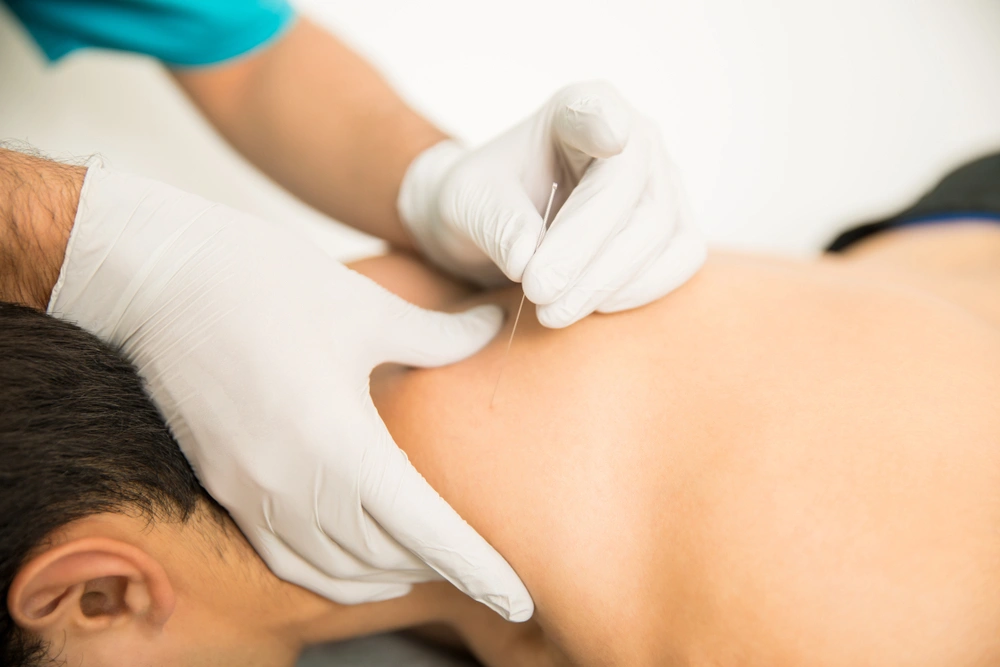A lot of attention has come to this technique in the recent years. Most people have heard of it but never tried. And those who tried it might just love it or hate it. Before you judge here are some things you need to know
What is dry needling?
The treatment technique called dry needling is defined by the American Physical Therapy Association (APTA) as a skilled intervention that uses a thin filiform needle to penetrate the skin and stimulate underlying myofascial trigger points, muscular, and connective tissues for the management of neuromusculoskeletal pain and movement impairment.
What is a trigger point?
A trigger point (TrP) is a hyperirritable spot in a taut band of skeletal muscle that is painful on compression, stretch, overload or contraction of the tissue which usually responds with referred pain that is perceived distant from the spot. The nature of the onset is still unclear. It is thought that is due to an excessive release of acetylcholine into the motor endplate. The increased motor plate activity leads to a continual release of calcium ions (Ca +2) that is responsible for the muscle contraction. This leads to a local muscle contraction that is persistent and involuntary because is chemically induced.
Trigger points can be active, passive or latent. Active TrPs cause a reproduction of the patient’s familiar pain with or without palpation. Passive trigger points do not cause pain except when stimulated via palpation. With latent TrPs, the local and referred pain do not reproduce any symptoms familiar or usual to the patient when palpated.
Can Physiotherapist do Dry needling?
Yes. In 2010, jurisdictions sought information from the Federation of State Boards of Physical Therapy (FSBPT) regarding the criterion for physical therapists to be able to practice dry needling. In 2015, the FSBPT, APTA, and seven dry needling experts composed a task force that set forth a final set of competencies for physical therapists for the safe and effective use of dry needling in clinical practice.
How does it work?
The needling hand places the needle and guide tube at the site.. The needle is tapped into the epidural layer of the skin and the guide tube is discarded. The dominant hand is used to insert the needle perpendicular to the muscle superficially to the subcutaneous tissue, or deep into the muscle to penetrate the trigger point. This is known as superficial (SDN), or deep dry needling (DDN/TrP-DN) respectively. The needle can be left in situ for a short period of time (up to 20 minutes) or pistoned in and out of the muscle, causing a twitch response from the trigger point. During a pistoning technique, once the acetylcholine is depleted at the end plate, the twitching will stop and the needle is removed and discarded appropriately in a sharps container.
What should I expect?
Clinicians can apply needles to a number of trigger points during each treatment session. Usually, pain relief lasts 3-4 days after the first treatment session. The duration of the pain relief may be longer following subsequent sessions. Up to three or four treatments may be required initially to eliminate a trigger point, and no single trigger point should be needled more than twice in a week.
The most common adverse effect associated with dry needling is soreness in the first 24 hours post treatment. Another uncommon side effect can be bruising. Application of heat and stretching exercises may minimize this, and aggressive treatment should be avoided until the patient’s reaction to dry needling is known. High quality needles, which are sharper and thinner, may also reduce pain during and after treatment.
What is it indicated for?
Dry needling may be indicated for myofascial pain with the presence of trigger points. Trigger points may lead to impairments in body structure, pain, and functional limitations. Dry needling has been shown to be beneficial in addressing strains, osteoarthritis, and tendinopathies.
Dry needling is a relatively new treatment modality used by physical therapists and other common musculoskeletal conditions seen in athletes. It is a safe, inexpensive, and minimally invasive procedure that carries a low risk. Further studies are also warranted to study the effects of different dry needling protocols for muscular, tendon, and potentially ligament conditions.
To learn more about Dry needling, please visit our dedicated page here: Dry needling
